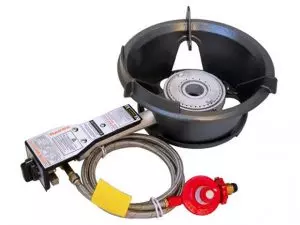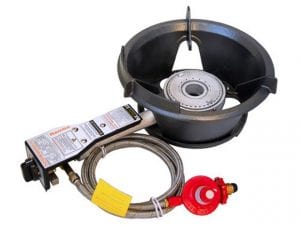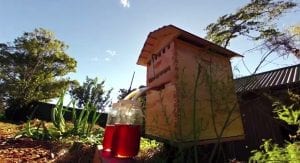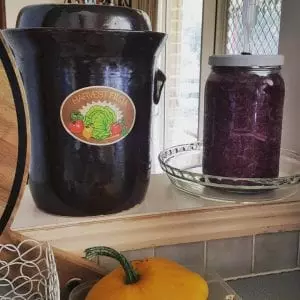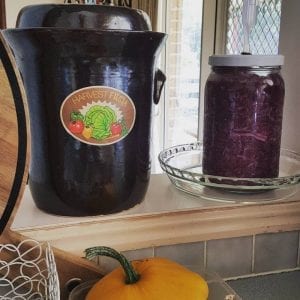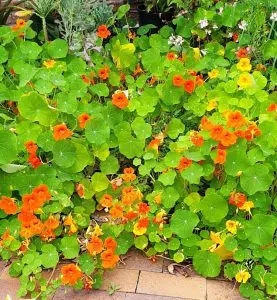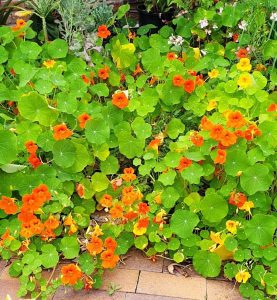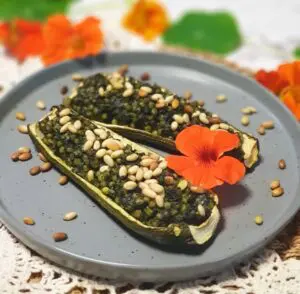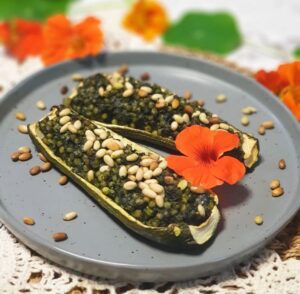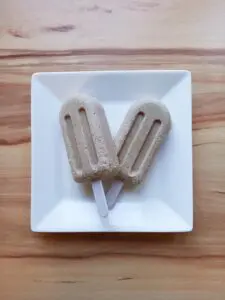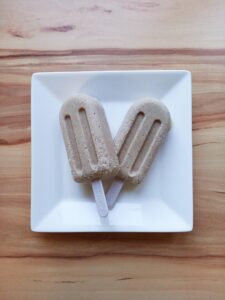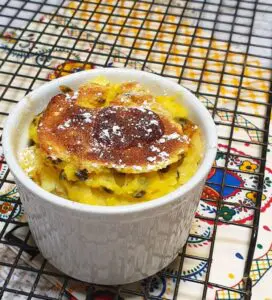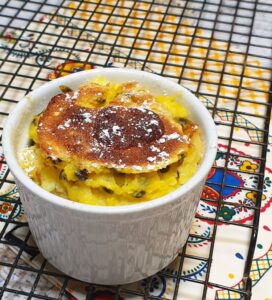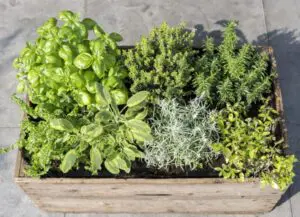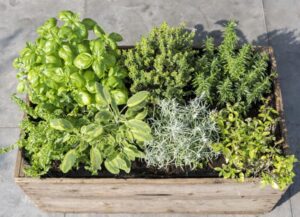The famous pickle
Cucumbers are the most famous of all pickles, so famous that if I asked, “would you like a pickle?” You would probably assume I was offering a pickled cucumber when in fact a pickle can mean many different foods – which have been pickled (like peppers).
As I explained in our last article, How and why to grow cucumbers, pickled cucumbers are so important even massive food chains are made off the back of this simple ingredient. Ok, so it may be a little tongue-in-cheek to say sliced pickles are the backbone of McDonalds but still, this humble ingredient is integral to many of their burgers (even if they do end up stuck to the roof and windows).
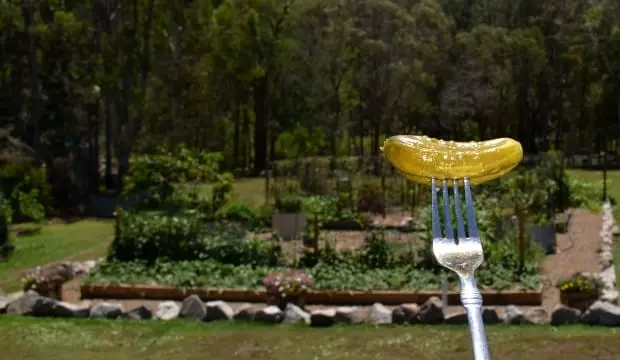
A pickled cucumber and the garden from where it came (image above)
A pickled cucumber or gherkin, whatever you like to call it, is without doubt one of the world’s most common and oldest preserved foods whether eaten in isolation or combined with other ingredients. Whoever was the first person to pickle a cucumber definitely deserves a big self-sufficiency award and our gratitude for realising the pickling potential of this fabulous fruit.
Pickling cucumbers
Pickling cucumbers isn’t rocket science and really is very simple to do. The great thing about pickling cucumbers is the fruit doesn’t have to be overly processed or prepared and even the pickling solution is usually just a simple matter of bung together, bring to the boil and that’s it. Compared to other forms of preserving like jams and marmalades; for instance, cucumbers are a cinch.
There are many ways to pickle cucumbers from cold fermentation, to hot water bath canning, to using ice, to salting, or combinations of ways and methods. The key is to experiment and adjust recipes (even mine) until you find a way/s you and your family prefer. Lacto fermentation is a great way to naturally pickle cucumbers but the following recipes are vinegar based – see our other articles on lacto fermentation (just do a search above) or check out this article on fermentation because the same principals apply when fermenting cucumbers as outline for other produce in that article.
Also, for pickled cucumbers to be a success the chemical process and natural preserving agents need to be done right. All jars and containers used to store the final product should be carefully sterilised and be in good condition. Enough salt should be used and sugar (where applicable) to restrict the growth of any bad bacteria and it’s important that a good quality vinegar is used 5% or more – most standard distilled vinegars are fine to use even if a percentage is not shown, but be wary of malt and salad dressing vinegars with low acidity because they are not suitably acidic for pickling.
Mark’s fennel pickled cucumber recipe

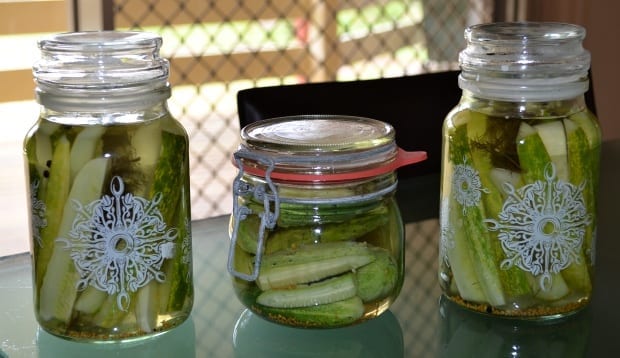
Home made pickled cucumbers using recycled jars (above image)
Fennel isn’t the first spice that comes to mind when pickling cucumbers (dill probably is); however, fennel goes really well with pickles. I decided to try fennel as the hero spice in my pickled cucumbers once because I happened to run out of fresh dill and it was such a hit that we now we use fennel regularly as a pickling spice for cucumbers.
What we noticed when using fennel is it works best for sweet pickles (when you use sugar in the recipe) but you can still use fennel for unsweetened pickles too, it’s personal preference I think.
Ingredients
Cucumbers – about 3 kilograms of preferably the smaller gherkin kind but any young cucumber like Lebanese or any type really will do. Try to select cucumbers which are no more than 6 inches long and if using whole then 3 inches or less is perfect.
Pickling liquid (makes enough for 6 large jars)
5 cups vinegar (3 x plain white & 2 x apple cider)
5 cups of water
5 table spoons cooking salt
2 cups sugar
1 x teaspoon black peppercorns
2 x teaspoons yellow mustard seed
3 x cups of fresh fennel (roughly chopped)
Method
Add the pickling ingredients to a saucepan and bring to the boil then remove from the heat and leave steep. It is not essential that the pickling liquid cools down for this recipe but it doesn’t matter if the liquid does cool before bottling. 
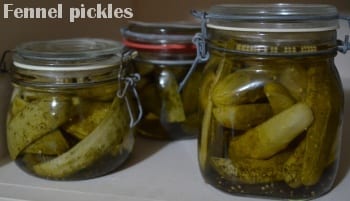
Depending on the size of the cucumbers either keep whole or quarter lengthways and remove the seeds with a spoon. Small cucumbers (3 inches or less) are a good size to pickle; whereas, larger cucumbers at around 6 inches are better sliced lengthways and de-seeded. Slicing large cucumbers across in thin discs works also with this recipe.
Pack the cucumbers into sterilised jars. If you have a mixture of small and large cucumbers whole and sliced then try and group the same kinds together where possible – ie, all the smaller whole pickles in a jar and sliced pickles in another jar etc.
Pour the pickling mixture over the pickles with an even distribution of herbs in each bottle and ensuring the liquid covers the pickles fully. Then seal the jars and store in a cool dark place like under the stairs, in a cellar, or the back of a pantry.
Leave to mature for about 4 weeks and refrigerate after opening. The pickles should last 12 months or more unopened and a few weeks after opening.
Notes
Scale the ingredients down for smaller quantities of cucumbers.
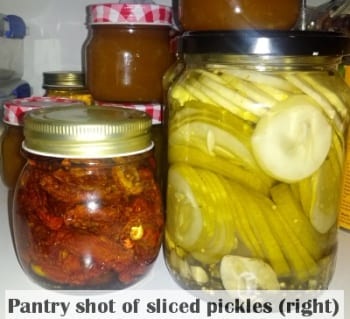
Ensure the lids on the jars are sealed tightly and if using metal lids inspect them first to see if the plastic coating is intact if bare metal is showing this will react with the acid pickle solution. I sometimes use recycled coffee jars which have a pop-on lid; therefore, to make sure the lids seal and don’t rise or come off during the maturing process, I use duct tape as an extra measure to seal the lids (I’m not recommending this bottle method however; and in truth, proper jars purchased new are best used).
Use dill or other herbs to experiment with the taste. For a sharper taste, use less sugar and substitute the cider vinegar with white wine vinegar instead. Likewise for sweeter pickles add more sugar.
Once bottles are sealed, if you notice the pickling solution getting cloudy overtime then discard because it’s likely they have become contaminated – the pickling solution should remain relatively clear and similar to when they were first bottled.
Once a jar is opened, store in the refrigerator.
Sliced Dill Pickles No Sugar McDonalds Style
For a fresh taste this no sugar savoury pickle recipe is a crunchy journey between the old standard dill pickles and the McDonalds burger pickle. We love them, because of the versatility these pickles offer as they are not overpowering (if used sparingly) and are terrific for sandwiches/rolls; in salads, or just eaten on their own (This recipe makes three to four 600 mil jars).

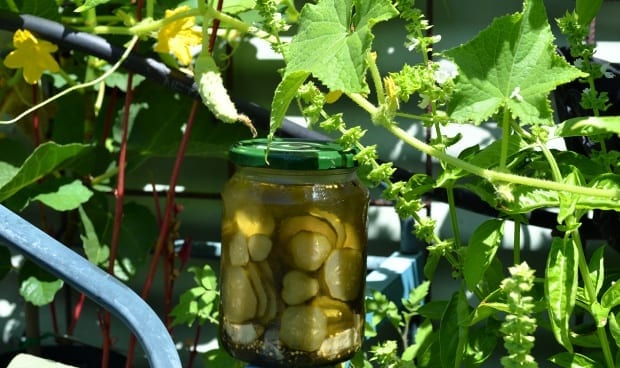
Pickled sliced cucumbers growing on the side of water tank ready to be picked (above image)
Ingredients
Cucumbers very fresh – about 10 no more than 6 inches long you may need a few more depending on sizes (young is best so when sliced you can see the seed inside are not overly developed).
Pickling solution
3 x cups apple cider vinegar
3 x cups water
9 large garlic cloves/segments peeled, squashed with the back of a knife & cut in halves
5 tablespoons of salt
2 tablespoons dried dill (or one cup of fresh dill chopped)
1 x tablespoon peppercorns
1 x tablespoon yellow mustard seed
Method
Wash cucumbers and slice thinly (about 2 mils).
In a pot combine all (except the cucumber) and heat to boiling; then, remove from heat.
Remove garlic and distribute evenly between jars, then tightly pack cucumbers leaving about ½ inch clearance at top of jar.
Pour hot vinegar solution over cucumbers to cover and place lids on jars.
Process 5 minutes in boiling water bath.
Some easy salad recipes that include pickled cucumbers
Below are a few salad recipes we use at home which include the pickled cucumbers from the above recipes. Either pickled cucumbers can be used in the recipes below or my preference is the sharper tasting dill but you may prefer the sweeter fennel instead (my wife does).
Quick Fresh CCTP Salad Recipe
Ingredients
One large Carrot (if you can grow your own big purple variety that’s even better)
One large bell Capsicum or several smaller ones (easy to grow in most regions)
1 dozen cherry Tomatoes (you know my thoughts on cherry tomatoes, please try and grow your own as paying for a small punnet at the grocer is bordering on a scam)
1 cup of sliced dill pickled cucumbers – cut in halves.
1 x Tablespoon extra-virgin olive oil
Seasoning to taste
Method
With a peeler, remove the outer skin of the carrot (discard) and then into a salad bowl continue to shave/peel lengthways the whole carrot down to the core (you may need to turn the carrot and shave from different sides as you go).
With a knife, slice the capsicum lengthways as thin as possible and add to the bowl. Cut the cherry tomatoes in half and add also.
Add the pickles and use a tablespoon of the pickle juice to splash over the salad.
Add the olive oil, season, and mix the salad together thoroughly.
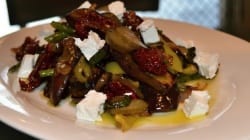
Ready to serve, tasty, and very healthy.
An antipasto style salad
This is for the cultured taste buds and those who like the occasional European taste sensation. Don’t waste it on the “chips and meat pie guy” as he probably won’t touch it.
Ingredients
½ cup sliced dill pickled cucumbers plus a table spoon of same pickle solution/juice
½ cup semi-dried tomatoes
½ cup Greek feta cheese (small cubes or crumbled)
½ cup chopped snake beans (or any beans)
Capsicum – several small or one large (with seeds removed)
5 x slices of thinly sliced young eggplant (aubergine) into inch wide strips about 5 mils thick
½ cup onions chopped
1 or 2 garlic cloves chopped finely
2 x table spoons of good quality extra virgin olive oil
*Optional – a few chillies sliced across in segments (mild jalapenos work well)
A pinch of salt and pepper
Method
Grill or dry-fry in a pan (without any oil) the capsicum, eggplant, onions, garlic, and optional chillies/jalapenos until wilted and brown (of course, you could use ready prepared antipasto eggplant and capsicum).

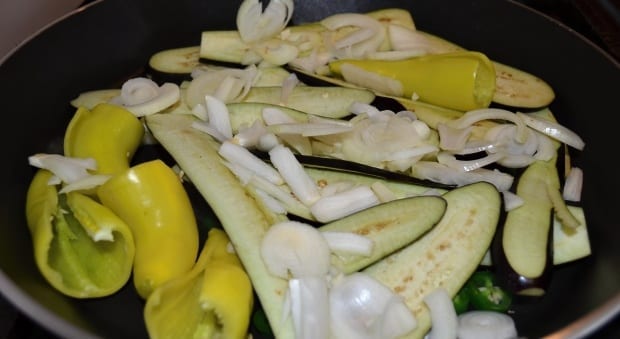
Peel as much of the skin from the blistered capsicums as possible and then slice into thin strips.
Blanch the beans for 2 minutes in boiling water then drain and leave to cool.

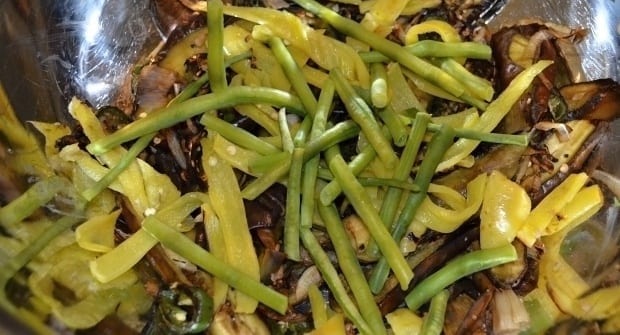
Except for the feta, combine and toss all the ingredients together in a serving bowl including the olive oil and seasonings. Leave it sit and cool or go warm, at least.
Place on a serving dish and sprinkle the feta randomly on top – that’s it!
Another way to serve is to divide into small/mini side bowls and present on a tray with a cocktail fork. A nice light red wine at the same time could go down a treat also…

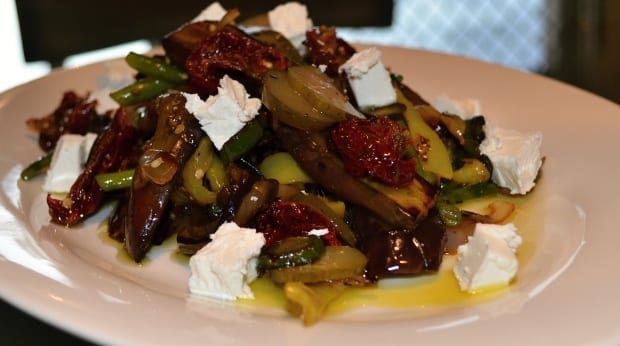
Antipasto salad with sliced pickled cucumber, dry roasted capsicum and eggplant, semi-dried tomatoes, jalapenos, dressed with olive oil and topped with feta cheese (image above)
Conclusion
Well, I hope you enjoyed this article on pickled cucumbers and I hope it inspires some people to grow their own cucumbers and have a go at pickling them. My cucumber pickling recipes above work for me and my family and I expect you’ll enjoy them too; but remember, if the taste is not quite how you like make some adjustments like: adding more sugar, reducing salt slightly, using different vinegars, other herbs and spices, or even different types of cucumber.
You may find some small adjustments to a recipe can make a world of difference and create a pickled cucumber you just can’t stop snacking on whilst the fridge door is ajar.
Feel free to use the comment section below to leave your recipe hints, feedback, and questions. Also, please consider becoming a member of our forum and we can discuss pickling there in our preserving section.
Thanks for reading and thanks for your support.
Look, and see the Earth through her eyes
Mark Valencia – Editor SSM





